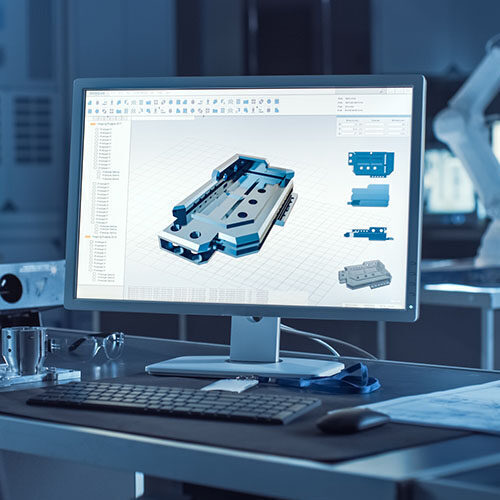
The Impact of the Coronavirus on the Manufacturing Industry
Last January when we first started to hear reports about the novel coronavirus, few, if any of us, realized the changes that were to come — or that a year later we would still be living in an altered world, coping with the virus.
The global pandemic has brought change and uncertainty like nothing before to every industry across the globe, including the manufacturing industry.
Different Industries, Different Impacts
Some sectors within the manufacturing industry, such as manufacturers in the aviation industry, have experienced significant losses and declines, while others have seen increases in demand for their products, like those manufacturers that create goods connected to the spike in home improvements and repairs, as people look to fill their time while they remain at home.
Other manufacturers, still, have had to pivot and shift their priorities to manufacturing personal protective equipment (PPE), hand sanitizer, and other materials and equipment needed by the healthcare industry in their fight against COVID-19.
Government-mandated shutdowns have also had differing consequences on the industry. Some manufacturers have been forced to shut down their operations for extended periods of time, while others have been able to continue operations — although with new public health measures in place to safeguard their workforce while they continue to produce essential goods.
After the first wave of pandemic-driven shutdowns, recoveries in the manufacturing industry have been uneven. Some sectors are operating close to pre-pandemic levels while others continue to face decline. With the second wave of the virus currently underway, it is difficult to predict what will happen next for many sectors.
Overall, the economic recovery to reach pre-pandemic levels will most likely take some time. For example, Deloitte anticipates a decline in annual manufacturing GDP levels of 5.4% for 2021 in the United States.
With so much change and uncertainty in a short period of time, including strains on global supply chains, changes to daily operations, and declines in sectors that were once-booming, the manufacturing industry looks completely different than only a year ago.
Even when the COVID-19 pandemic subsides, hopefully later this year, it will leave behind a changed economic landscape for manufacturers.
Changes to Human Capital & Labor
One of the biggest changes manufacturers have seen is a change to their workforces, and the daily operations of their workforce. While many businesses were able to successfully move to remote-working at the start of the pandemic, the manufacturing industry was not as it requires workers to be on-site to produce goods.
Many manufacturers, especially in the early months of the pandemic, unable to have their staff work-from-home under government-mandated shutdowns to reduce the spread of the virus were forced to close shop and lay-off workers.
A significant dip in manufacturing employment levels, largely due to these forced shutdowns in the early days of the pandemic, as well as to changes in demand and supply, was seen in 2020. April 2020 recorded the manufacturing industry’s lowest employment levels in the United States since 2010.
As manufacturers have been allowed to re-open and the economy has begun to recover, many workers have been re-hired, but employment levels are still lower than they were pre-pandemic.
Once manufacturers were allowed to operate again — or those producing essential goods who were never shut down in the first place — major changes had to be implemented to their daily operations to ensure the ongoing safety of their staff.
While some front office staff have been able to move to flexible and remote working arrangements, most manufacturing staff must be on-site for their shifts. New health and safety standards, including increased sanitation, mandatory PPE, social distancing, and barriers between work stations have had to be implemented.
Many plants have changed schedules and separated shifts to accommodate for physical distancing rules. Some manufacturers have reported an increase in hiring temporary employees to fill crews as they have had to separate shifts to reduce interaction. Others have had to move around their staff as their operations shifted to manufacturing essential goods only.
Changes not only in staffing levels, but to how employees carry out their jobs every day has been a major change for manufacturers. Until vaccines are fully distributed, manufacturers will have to continue to ensure that their first priority is the health and safety of their workers, meaning these changes will be in effect for many months yet.
To better manage their operations, many manufacturers have invested in, and will continue to rely on, automation technologies like autonomous materials movement and the industrial internet of things (IIoT) to decrease worker density and distance between workers throughout their plants. This will have a huge and lasting impact on the industry and will increase the move towards Industry 4.0.
Opportunities for Manufacturers
The global pandemic has sped up the shift to domestic production for all types of manufacturing, as countries across the globe want to ensure that they are able to produce vital goods for their own consumption.
A shift towards local economies has been underway in the last few years due to international trade tensions, and other related factors, but the pandemic appears to be speeding up this change. The manufacturing industry is expected to see more ‘reshoring’ of manufacturing operations, and the building of new factories, including the revitalizing of older plants, is a trend that is expected to continue over the next few years.
But it is anticipated that many of these new factories will not look like manufacturing operations of old — expect smaller, more automated operations that are able to adjust their production lines quickly as demand shifts.
This, in turn, will create opportunities for other smaller, custom manufacturers, especially for those that manufacture automation components, and “integrators” who put together automated systems.
The shift to more domestic production is a big opportunity for manufacturers of all sizes, and one that manufacturers should prepare to take advantage of.
Challenges for Manufacturers
The pandemic continues to create challenges for manufacturers that serve industries that have seen major downturns during the pandemic. The decrease in global travel and the slump in energy production caused by the pandemic has led manufacturers that are reliant on these industries to have to reconfigure their operations — or close up shop.
Some specialist manufacturing companies that are heavily tied to these struggling industries are looking at how they can reconfigure their products and processes for other, more profitable markets. As a part of that move toward diversification, manufacturers also need to look ahead, identifying categories that are likely to outperform in a new economy.
Liquidity continues to be a challenge for many manufacturers as well in the current economy. In some cases, projections of when things may return to normal have proven overly optimistic, and it’s important for manufacturers to plan for the possibility that the current disruptions may continue longer than expected. Adding to these challenges is uncertainty about further government stimulus in 2021 and beyond.
Manufacturers need to keep a close eye on their financials and manage their operations as best they can to keep their operations running through lean times.
Supply chains also continue to be a persistent problem for manufacturers. Early on in the pandemic, there was a huge amount of supply chain disruption, as manufacturers across the globe were affected by the pandemic and government-imposed restrictions on their operations.
While some of this has subsided as the world has learned how to effectively keep operations safe and open, supply chains continue to be more fraught than they were pre-pandemic.
The early days of the pandemic saw many manufacturers create ‘war rooms’ that brought together demand-and supply planners to manually share updates in real-time. Now many manufacturers have learned to rely on technology that allows them to automate their processes to gain greater visibility and real-time understanding of activities across a complex supply network, making it easier for them to manage their supply chains.
How Should Manufacturers Respond In the Short-Term?
As manufacturers move ahead in a changing landscape, they must adapt to multiple challenges, often by changing processes and practices that they have relied on for years. Technology solutions will play a big part in helping manufacturers keep costs down and operational efficiencies high, as well as making them better able to navigate the uncertainty that the next few months, and possibly years, will bring.
Many industries have had to change their business practices quickly: Amid the explosion in online shopping due to the pandemic meaning many retailers have had to quickly grow their online presence and find fast and efficient shipping options.
Manufacturers too must adjust to the changing business climate caused by the pandemic. Until the vaccine is fully distributed, plant closures (full or partial) could continue to be necessary for manufacturers in certain hard-hit regions. For companies worried about outbreaks, closures, business continuity, contingency plans, and keeping their staff safe, it is critical that they explore the use of automation technologies.
Automation, which can help protect workers’ health by minimizing contact with one another, will also help companies reduce labor costs further down the road.
Companies that have already started to embrace this new world of technology, like the IIoT have seen a 7% revenue growth advantage over their peers.
The economic and social downturn caused by COVID-19 will create a much deeper divide between manufacturers who have just started to digitize, and those who are much further along on their digital journey.
While small- to mid-sized manufacturers may not be able to invest in full-scale automation all at once, they can explore along the edges of their manufacturing processes, identifying one or two areas that can be automated and proceeding in a slower, but well thought out manner, to ramp up automation in their shops.
More traditional technologies can also help small- to mid-sized manufacturers. Systems like Enterprise Resource Management (ERP) systems can help manufacturers connect and integrate their manufacturing processes, making their shops more efficient.
ERPs, with their real-time data capabilities, are also able to help manufacturers manage some of their biggest challenges stemming from the pandemic, such as with supply chain management. Industry forecasters expect that the supply chain impact of COVID-19 will spur manufacturers’ spend on enterprise resource planning (ERP), to reach $14 billion in 2024.
Conclusion
2021 will vary for manufacturers depending on their sector and where they have felt the greatest impact from the pandemic.
Some will be pivoting their focus, trying to rebuild lost revenue streams, while others will be trying to keep their operations efficient amid the continuing effects of the pandemic.
But all manufacturers should continue to increase the agility of their operations. By continuing to invest in technology and automation solutions, manufacturers can set themselves up to be in the best possible shape to continue to weather the COVID-19 pandemic — plus put themselves in a better position once the pandemic has ended and the economic recovery is in full swing.
In all likelihood 2021 will be a tumultuous year, following in the footsteps of 2020. But by year’s end, hopefully, the worst of the pandemic will be behind us, and we can all continue to recover and move forward.
Get your eBook Scared to implement a new ERP?
"*" indicates required fields



